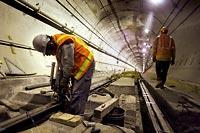Metro delays shorter than feared

Sixth months after the Metro bus tunnel was closed for renovation and bus traffic was moved above ground, the time it takes to travel through downtown during rush hour has increased by about two and a half minutes, according to a report released by Metro.
The report found that the average trip through downtown Seattle before the tunnel closed was 21:59 minutes based on bus trips between 4 and 6 p.m. on weekdays during July.
After the closure, the time was 24:30 minutes, an increase of 11 percent.
Critics worried the closure would jam downtown streets and cause traffic chaos; city officials said it would add just two minutes to the bus commute between Stewart and Jackson streets.
The tunnel closure affected 36,000 passengers on 21 tunnel routes that now travel on Seattle streets. The changes also closed Third Avenue to cars during rush hour.
As part of the closure, Metro is required to monitor the tunnel closure and has released two reports, a baseline report last fall and the one just published.
The increased time was blamed in part on congestion in the Stewart and Virginia Street corridors and the increased travel time for buses on surface streets.
That's since been changed, said John Layzer, the city's Sound Transit program manager who helped write the report.
Stewart Street was a problem because buses that once entered the downtown tunnel instead traveled on Stewart and traffic soared. While buses used to stop at every Stewart Street Metro stop, that has been switched to the "skip stops" on Third Avenue, where buses don't pull in at every stop.
The city also has put in more parking restrictions on Stewart during peak periods, eliminated a bus stop in front of the Westin Hotel and relocated some buses off Stewart.
Even something as simple as installing a pedestrian signal at Second Avenue and Stewart Street helped keep traffic flowing, Layzer said.
"Overall, it's gone very well, but there aren't silver bullets to these problems," Layzer said. "Nothing matches the speed and reliability of the tunnel itself. For those riders who used to ride in the tunnel, their trips are longer."
While it used to take eight minutes to travel through the tunnel from the International District Station to the Convention Center Station, that trip on surface streets takes from 14 to 23 minutes longer.
Metro said the closure doesn't seem to have affected the number of bus riders. On Route 41, the most popular tunnel route, the number of riders dropped slightly from 6,668 daily average riders in fall 2004 to 6,650 in fall of 2005, after the tunnel closure.
Ellen Bevington, who worked on the report for Metro, said people's worst fears about the tunnel closure haven't materialized.
"Tunnel riders haven't been pleased, but there's no way we could replicate that [tunnel] service," she said. "In general, downtown has worked well."
The next major report on the closure will be released in July.
Meanwhile, Metro continues to work on the tunnel rail project. Layzer said he's hoping the stub tunnel under Pine Street will be completed by Thanksgiving.